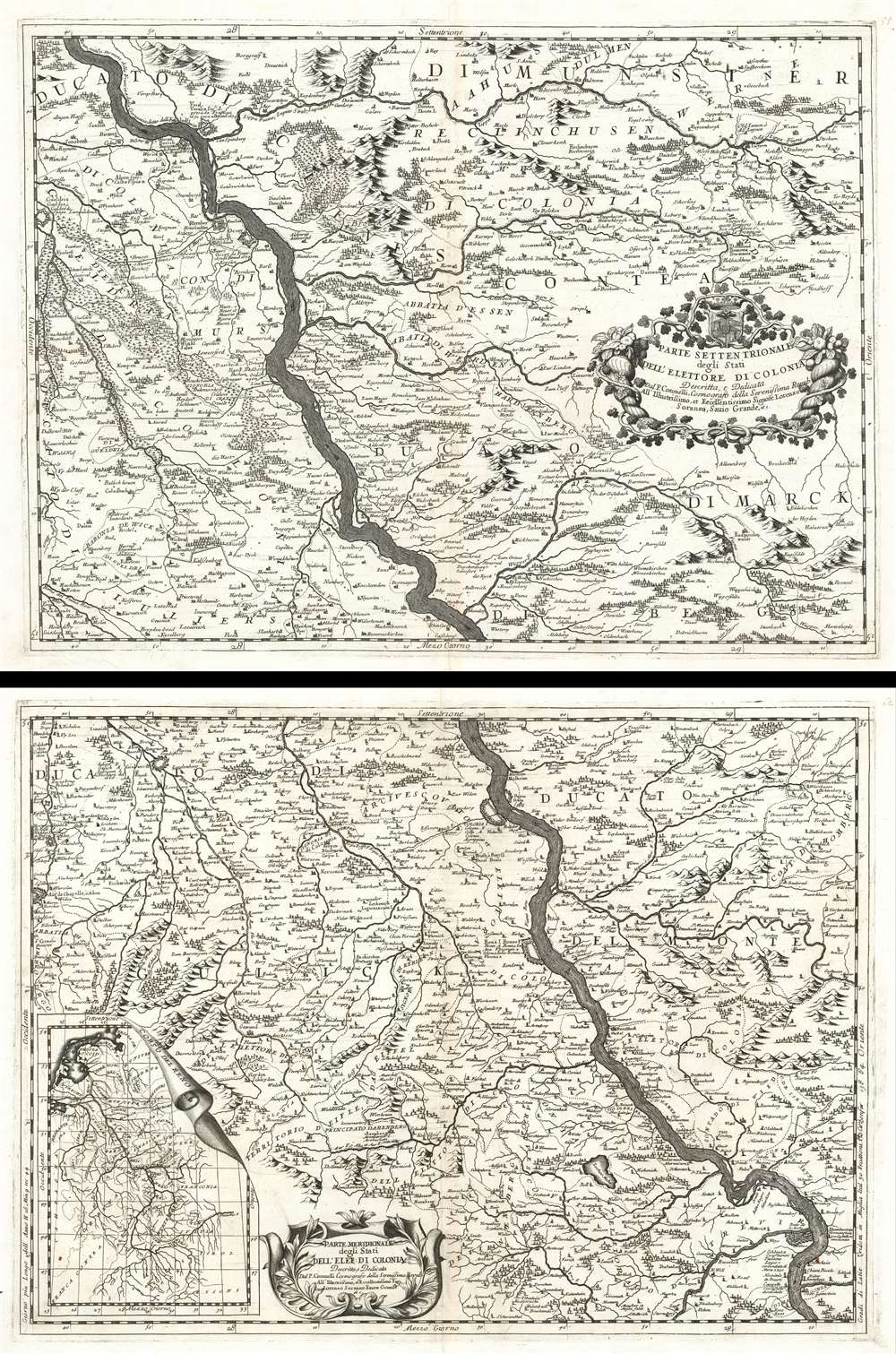1690 Coronelli Map of the Rhine River Between Wesel and Koblenz, Germany
RhineRiver-coronelli-1690
Title
1690 (undated) 18.5 x 25 in (46.99 x 63.5 cm)
Description
The Electorate of Cologne
The Electorate of Cologne was an ecclesiastical principality of the Holy Roman Empire beginning in the 10th century until the early 19th century. Based around the power of the Archbishop of Cologne, the Archbishop ruled over his temporal possessions or Hochstift as a prince-elector. Germanic tribesmen first began living at the site that became Cologne in 38 BCE, and the Romans founded Colonia Agrippina at the site in 50 AD. After nearly a millenia, Emperor Otto I of Germany appointed his brother, Bishop Bruno, as a duke, handing the archbishops of Cologne their first taste of secular power. Otto endowed his brother and his successors with the powers of secular princes. Cologne served as the capital of the electorate until 1288, when, during the Battle of Worringen, when Archbishop Siegfried of Westerberg was captured by the citizenry of Cologne and forced to declare Cologne a Free Imperial cCity to regain his freedom. After this trying experience, the archbishop fled to Bonn. Both Bonne and Cologne were occupied by France in 1794.Publication History and Census
This map was created and published by Vincenzo Coronelli in 1690. Only one example of each sheet is recorded in the OCLC and they are part of the collection of the Bibliothèque nationale de France in Paris.Cartographer
Vincenzo Maria Coronelli (August 16, 1650 - December 9, 1718) was an important 17th-century cartographer and globe maker based in Venice. Coronelli was born the fifth child of a Venetian tailor. Unlikely to inherit his father's business, he instead apprenticed in Ravenna to a woodcut artist. Around 1663, Coronelli joined the Franciscan Order and, in 1671, entered the Venetian convent of Saint Maria Gloriosa dei Frari. Coronelli excelled in the fields of cosmography, mathematics, and geography. Although his works include the phenomenal Atlante Veneto and Corso Geografico, Coronelli is best known for his globes. In 1678, Coronelli was commissioned to make his first major globes by Ranuccio II Farnese, Duke of Parma. Each superbly engraved globe was five feet in diameter. Louis IV of France, having heard of the magnificent Parma globes, invited Coronelli to Paris, where from 1681-83 he constructed an even more impressive pair of globes measuring over 12 feet in diameter and weighing 2 tons each. The globes earned him the patronage of Louis XIV and privileged access to French cartographic information from Jesuit sources in the New World, particularly Louisiana. Coronelli returned to Venice and continued to publish globes, maps, and atlases, which were admired all over Europe for their beauty, accuracy, and detail. He had a particular fascination for the Great Lakes region, and his early maps of this area were unsurpassed in accuracy for nearly 100 years after their initial publication. He is also well known for his groundbreaking publication of the first accurate map depicting the sources of the Blue Nile. At the height of his career, Coronelli founded the world's first geographical society, the Accademia Cosmografica degli Argonauti, and was awarded the official title Cosmographer of the Republic of Venice. In 1699, in recognition of his extraordinary accomplishment and scholarship, Coronelli was also appointed Father General of the Franciscan Order. The great cartographer and globe maker died in Venice at the age of 68. His extraordinary globes can be seen today at the Bibliothèque Nationale François Mitterrand in Paris, Biblioteca Marciana in Venice, the National Library of Austria, the Globe Museum in Vienna, the Library of Stift Melk, the Special Collections Library of Texas Tech University, as well as lesser works in Trier, Prague, London, and Washington D.C. Coronelli's work is notable for its distinctive style, which is characterized by the high-quality white paper, dark intense impressions, detailed renderings of topographical features in profile, and numerous cartographic innovations. More by this mapmaker...

